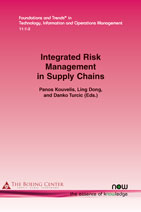The Interaction between Operational Flexibility and Financial Flexibility
By Onur Boyabatli, Lee Kong Chian School of Business, Singapore Management University, Singapore, oboyabatli@smu.edu.sg | Tiecheng Leng, Lingnan College, Sun Yat-sen University, China, lengtch@mail.sysu.edu.cn
Abstract
This paper examines the interaction between operational flexibility and financial flexibility in a multi-product business unit that makes operational decisions based on financial resources provided by its parent company (or headquarters). We capture operational flexibility through investment in flexible technology and financial flexibility through higher availability of financial resources. We consider the flexible-versus-dedicated technology choice and capacity investment decisions of a two-product business unit under demand uncertainty in the presence of budget constraints. The unit operates under a capital budget for financing the capacity investment, and an operating budget, which is uncertain in the capacity investment stage, for financing the production. We investigate how financial flexibility in the capacity investment stage (as captured by the stringency of the capital budget) and financial flexibility in the production stage (as captured by the likelihood of having sufficient operating budget to fully cover the production cost) shape the optimal technology choice. We identify the critical role that the relative capacity intensity (the ratio of unit capacity cost to total unit capacity and production cost) of each technology plays. Our results have implications about how to deploy technologies with different capacity intensity profiles, which are shaped by automation level or plant location choices.
Integrated Risk Management in Supply Chains
Integrated Risk Management in Supply Chains examines supply chain risk management. The increased interest in the topic is due to a number of factors including the increased volatility of commodity prices and exchange rates, recent natural disasters, and the increased importance of multinational corporations. The motivation for risk management comes from a variety of sources: financial distress costs, managerial incentives, and other important reasons discussed in the remainder of this book. Understanding the motives is important because they provide insights into which risks should be managed and how a firm’s risk management operations should be organized.
The first part examines Buffering Supply Chain Risk with Operational Flexibility and deals with uncertainty in the form of routine variability, which includes fluctuations in demand. Part 2 reviews Supply Disruption. Both the preponderance of natural disasters and huge economic swings can cause extreme challenges across the supply chains. Although these types of risks are rare, they are highly consequential and buffering is insufficient to mitigate them. Instead, firms facing these risks must engage in contingency planning and must maintain redundancies in the system. This is why contingency planning is on the interface of operations and finance. Part 3 looks at Commodity Price Risks, which includes five papers on managing price risks – the first three papers are fundamental in that they ask “when” and “how” firms should manage price risks with hedging and how hedging affects operating policy and the remaining two papers examine the best practices in specific industries.

Companion
Foundations and Trends® in Technology, Information and Operations Management, Volume 11, Issue 1-2 Special Issue: Integrated Risk Management in Supply Chains
See the other articles that are also part of this special issue.